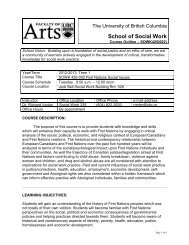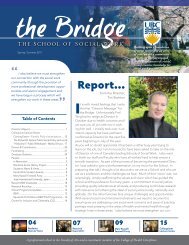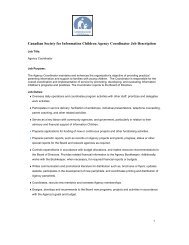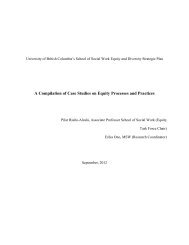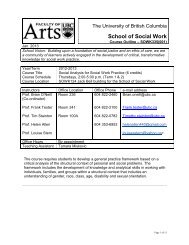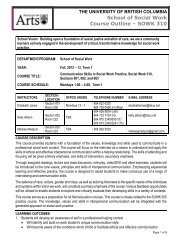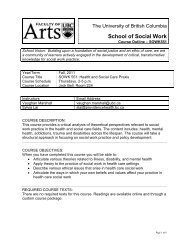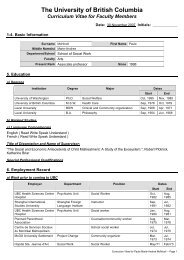Course Outline Format - School of Social Work - University of British ...
Course Outline Format - School of Social Work - University of British ...
Course Outline Format - School of Social Work - University of British ...
You also want an ePaper? Increase the reach of your titles
YUMPU automatically turns print PDFs into web optimized ePapers that Google loves.
The <strong>University</strong> <strong>of</strong> <strong>British</strong> Columbia<br />
<strong>School</strong> <strong>of</strong> <strong>Social</strong> <strong>Work</strong><br />
<strong>Course</strong> <strong>Outline</strong> – SOWK550(004)<br />
<strong>School</strong> Vision: Building upon a foundation <strong>of</strong> social justice and an ethic <strong>of</strong> care, we are<br />
a community <strong>of</strong> learners actively engaged in the development <strong>of</strong> critical, transformative<br />
knowledge for social work practice.<br />
Year/Term 2012-13 Term 1<br />
<strong>Course</strong> Title<br />
<strong>Course</strong> Schedule Wed. 1400-1700<br />
<strong>Course</strong> Location SOWK RM 326<br />
<strong>Social</strong> <strong>Work</strong> and <strong>Social</strong> Justice<br />
(In <strong>Social</strong> and International Development Settings)<br />
Instructor Office Location Office Phone e-mail address<br />
Frank Tester 241 or 022<br />
2-2100 or 2-3447 frank.tester@ubc.ca<br />
(workroom)<br />
Office Hours By appointment<br />
COURSE DESCRIPTION:<br />
This is a graduate course designed to familiarize students with concepts <strong>of</strong> social justice and their<br />
expression in human rights. The course helps students locate themselves in relation to principles <strong>of</strong><br />
social justice. Students will develop a practice framework that considers human rights and the<br />
ethics, values and principles guiding social work and other forms <strong>of</strong> development practice.<br />
LEARNING OUTCOMES:<br />
Students will:<br />
locate themselves politically and philosophically as persons working with an orientation to<br />
social justice in mind;<br />
<br />
<br />
<br />
<br />
learn about social justice in historical, theoretical and practice contexts by exploring theories<br />
<strong>of</strong> human rights and social development;<br />
patterns <strong>of</strong> power and privilege and the accessibility these deny or afford to those seeking<br />
social justice and socioeconomic opportunities;<br />
reflect upon ways in which cultural assumptions, beliefs, and value systems enhance or<br />
hinder practice with people <strong>of</strong> diverse backgrounds;<br />
become familiar with key texts that affect human rights internationally and in a variety <strong>of</strong><br />
practice settings;<br />
Page 1 <strong>of</strong> 9
SOWK550(004) 2012-2013<br />
<br />
become familiar with the concept <strong>of</strong> restorative justice and with the practice <strong>of</strong> administrative<br />
fairness.<br />
COURSE STRUCTURE:<br />
This course will be delivered in a combination <strong>of</strong> lectures, seminars, films, workshop and small<br />
group format.<br />
Students are expected to attend regularly and to come prepared to participate. While no grade is<br />
given for participation, the instructor may deduct up to 10% from your final grade if you have not<br />
attended or participated in class.<br />
Students must complete required readings prior to class. Different opinions, analyses and<br />
experiences in relation to the material dealt with in class will be dealt with in a respectful manner.<br />
There is an expectation that students will complete a one page reflective journal entry each week.<br />
REQUIRED COURSE TEXTS:<br />
Ball, Olivia and Paul Gready, 2006, The No-Nonsense Guide to Human Rights. Toronto:<br />
New Internationalist Publications.<br />
Curry-Stevens, Ann, 2003, Methods, Models and Materials for Anti-Oppression and <strong>Social</strong><br />
Justice <strong>Work</strong>shops. Toronto: Centre for <strong>Social</strong> Justice (on-line. Available at<br />
http://www.socialjustice.org)<br />
Reading Package (available from the UBC Bookstore)<br />
RECOMMENDED TEXT<br />
Ife, Jim, 2008, Human Rights and <strong>Social</strong> <strong>Work</strong>: Towards Rights-Based Practice.<br />
Cambridge, New York: Cambridge <strong>University</strong> Press. (I strongly recommend this book as<br />
one that will guide you through issues we will deal with in terms <strong>of</strong> other readings found in<br />
the reading package. We will also deal with some <strong>of</strong> the content in the last class).<br />
SUPPLEMENTARY READINGS:<br />
Please make extensive use <strong>of</strong> the very many resources to be found in the UBC library and<br />
the many texts (books, journals and reports) that are on-line.<br />
There are far too many potential supplementary readings and other materials to present a<br />
list here that would, necessarily, make sense. If you are interested in material that might<br />
compliment or supplement your interests, talk to me and I will do my best to point you in a<br />
possible direction.<br />
2
COURSE POLICIES [attendance, participation, academic dishonesty]:<br />
SOWK550(004) 2012-2013<br />
Excerpt from the UBC calendar:<br />
Regular attendance is expected <strong>of</strong> students in all their classes (including lectures, laboratories, tutorials, seminars, etc.).<br />
Students who neglect their academic work and assignments may be excluded from the final examinations. Students who<br />
are unavoidably absent because <strong>of</strong> illness or disability should report to their instructors on return to classes.<br />
The <strong>University</strong> accommodates students with disabilities who have registered with the Disability Resource Centre. The<br />
<strong>University</strong> accommodates students whose religious obligations conflict with attendance, submitting assignments, or<br />
completing scheduled tests and examinations. Please let your instructor know in advance, preferably in the first week <strong>of</strong><br />
class, if you will require any accommodation on these grounds. Students who plan to be absent for varsity athletics,<br />
family obligations, or other similar commitments, cannot assume they will be accommodated, and should discuss their<br />
commitments with the instructor before the drop date.<br />
It is recommended that students retain a copy <strong>of</strong> all submitted assignments (in case <strong>of</strong> loss) and should also retain all<br />
their marked assignments in case they wish to apply for a Review <strong>of</strong> Assigned Standing. Students have the right to view<br />
their marked examinations with their instructor, providing they apply to do so within a month <strong>of</strong> receiving their final<br />
grades. This review is for pedagogic purposes. The examination remains the property <strong>of</strong> the university.<br />
Academic Dishonesty:<br />
Please review the UBC Calendar “Academic regulations” for the university policy on cheating, plagiarism, and other forms<br />
<strong>of</strong> academic dishonesty. Also visit www.arts.ubc.ca and go to the students’ section for useful information on avoiding<br />
plagiarism and on correct documentation.<br />
____________________________________________________________________________________________<br />
ASSIGNMENTS<br />
(1) Journal (30%)<br />
Keep a journal. Each week, make the minimum <strong>of</strong> a one page entry. Your journal should be a<br />
response to the readings and materials dealt with each week. In some cases, you will be able to do<br />
this before the class. It will be a response to (reflections upon, reactions to, etc.) the readings for<br />
that week. In other cases – especially where we are viewing a film in class or have a guest – you<br />
may choose to do your entry ‘after the fact’.<br />
I am not looking for anything formal. What I would appreciate are candid and ‘<strong>of</strong>f the cuff’ responses<br />
to what you have read. I am quite accepting <strong>of</strong> things like ‘Yike! Verbage beyond description!! (could<br />
have said that in two sentences!!!)’ or ‘boorrrring! Fell asleep after 2 pages!’, or ‘Humm – that got<br />
me thinking about stuff I’ve never heard before.’ Etc. In other words, make it real. Make reference<br />
to the pages to which you are referring (where appropriate).<br />
Hand in the journal during the last class (which means you won’t have to comment on the last<br />
class). I realize that grading journals is very subjective. I will be looking for (a) ‘genuineness’ <strong>of</strong><br />
responses to the material; (b) evidence <strong>of</strong> critical thinking – things that you appreciated or<br />
didn’t find useful, relevant or expressed very well; (c) evidence that the reading was done<br />
(And I don’t necessarily mean all <strong>of</strong> it all the time. I just want to evidence that you made a valiant<br />
effort; which means that the context (what came before and after anything you comment on is<br />
usually relevant.)<br />
(2) Presentation on a Human Rights/<strong>Social</strong> Justice Declaration/Covenant/Bill (45%)<br />
Choose a document from the list on page 93 <strong>of</strong> Olivia Ball and Paul Gready, The No-<br />
Nonsense Guide to Human Rights. To this list is to be added, the United Nations Declaration on<br />
Human Rights (1948), the United Nations Declaration on the Rights <strong>of</strong> Indigenous People (2007),<br />
and the Canadian Charter <strong>of</strong> Rights and Freedoms (1982).<br />
3
SOWK550(004) 2012-2013<br />
Your job is (a) to introduce the class to the content <strong>of</strong> the document in question. You may use power<br />
point or any other means you deem appropriate for doing so. Given time constraints, this is an<br />
exercise in summarizing the main purpose and points <strong>of</strong> the document. (b) Deal with the text in a<br />
Canadian context. How has it been applied Choose a case or incident in which you are interested,<br />
where the document in question has been used or referred to in dealing with a human rights/social<br />
justice issue in Canada. (c) What are the strengths, weaknesses <strong>of</strong> the document in question, as<br />
revealed by the case you have chosen (d) In doing this, involve and engage the class in working<br />
with the material chosen for your presentation, using popular education techniques and approaches.<br />
In this regard, the references found in the on-line text, Curry-Stevens, Ann, 2003, Methods, Models<br />
and Materials for Anti-Oppression and <strong>Social</strong> Justice <strong>Work</strong>shops. Toronto: Centre for <strong>Social</strong> Justice<br />
(on-line. Available at http://www.socialjustice.org), will be useful. Think in terms <strong>of</strong> games, exercises,<br />
challenges, scenarios – a wide range <strong>of</strong> tools and devices to actively engage other students in<br />
discovering the material with which you are familiar. Think <strong>of</strong> yourself as an instructor working with<br />
social workers in an agency setting or at an NGO-sponsored workshop where you are introducing<br />
people to the material. Time management is important. You have 1 hour and 20 minutes for your<br />
presentation.<br />
(3) Scholarly Response (25%)<br />
The editors <strong>of</strong> the Journal <strong>of</strong> <strong>Social</strong> Justice and Public Affairs (fictitious) have invited you to respond<br />
to newspaper reports on a matter <strong>of</strong> social justice/human rights that has been topical (in the<br />
news) for the past three months. [Normally, the editor would invite you to respond to a particular<br />
matter <strong>of</strong> interest to the journal and its readers, but being the good-hearted soul that he is, he has<br />
decided to let you choose the issue that interests you most.]<br />
Your article will be published in the “Current Affairs” section <strong>of</strong> the Journal. It need not be long. It is<br />
not to be a full article (those appear in the refereed papers section). It has to fit within the word limit<br />
specified for brief articles in this section <strong>of</strong> the Journal (not more than 2000 words – although it can<br />
even be less!) Quality is more important than quantity when it comes to these things.<br />
Write your short article, commenting on or reacting to press coverage <strong>of</strong> a human rights/social<br />
justice issue <strong>of</strong> your choice. You might choose the way one publication (the Vancouver Sun or the<br />
Manchester Guardian or the New York Times or Georgia Strait or …) has covered something or you<br />
might do your piece on the way a number <strong>of</strong> publications have handled the topic, or you might chose<br />
to focus on the way a particular columnist has covered things (look out Margaret Wente!). Your call.<br />
But remember, this is a scholarly journal, so your response should be backed up by some<br />
reference to the literature. Proper referencing is required (Chicago style or APA). I say “some<br />
reference” because we don’t want a lengthy bibliography associated with this piece. No more than 6<br />
or 7 references.<br />
Our editorial panel will review your submission and get back to you (with a grade!). Due the last<br />
class.<br />
COURSE SCHEDULE<br />
Week 1: Sept. 5<br />
Graduate student orientation to the <strong>School</strong>’s organizing theme: social justice. All students must<br />
attend the two-day orientation, Sept. 4 and 5.<br />
4
SOWK550(004) 2012-2013<br />
Week 2: Sept. 12<br />
Introduction(s)<br />
Warm-up exercise (Who are we Getting in touch with your potato!)<br />
Film: The Bottom Line: Privatizing the World. What are the social justice issues raised by the<br />
film<br />
Resource: Curry-Stevens, Ann, 2003, Methods, Models and Materials for Anti-Oppression and<br />
<strong>Social</strong> Justice <strong>Work</strong>shops. Toronto: Centre for <strong>Social</strong> Justice (on-line. Available at<br />
http://www.socialjustice.org<br />
Week 3: Sept. 19<br />
What is <strong>Social</strong> Justice Readings (Available on-line through UBC Library)<br />
Solas, John. 2008. <strong>Social</strong> <strong>Work</strong> and <strong>Social</strong> Justice: What Are We Fighting For Australian<br />
<strong>Social</strong> <strong>Work</strong>. Vol. 61:2, 124–136.<br />
Ife, Jim. 2008. Comment on John Solas What are We Fighting For Australian <strong>Social</strong> <strong>Work</strong>. Vol.<br />
61:2, 137–140.<br />
Hugman, Richard. 2008. <strong>Social</strong> <strong>Work</strong> Values: Equity or Equality A Response to Solas.<br />
Australian <strong>Social</strong> <strong>Work</strong>. Vol. 61:2, 141-145.<br />
Solas, John. 2008. Is Equity Just Enough for <strong>Social</strong> <strong>Work</strong> A Response to Those Who Think it<br />
is! Vol. 61. # 2, 146-149.<br />
Solas, John. 2008. What kind <strong>of</strong> social justice does social work seek International <strong>Social</strong> <strong>Work</strong>,<br />
Nov. 2008; vol. 51: pp. 813 - 822. `<br />
Ife, Jim, 2008, Human Rights and <strong>Social</strong> <strong>Work</strong>: Towards Rights-based Practice (2 nd edition),<br />
Cambridge, New York, Cambridge <strong>University</strong> Press, (Chapter 1, Human Rights in a Globalized<br />
World, and Chapter 2, Human Rights: Beyond Traditional Formulations).<br />
Gregory, Derek, et al, 2009. ‘<strong>Social</strong> Justice’ Dictionary <strong>of</strong> Human Geography, London: Wiley-<br />
Blackwell (p.713). Available at:<br />
http://walk2geographies.files.wordpress.com/2009/03/gregory-etal_dictionary_human_geography_2009.pdfber 14, 2011.<br />
Fraser, Nancy, 2011. Reflection: Interview by Amrita Chhachhi. Development and Change, Vol.<br />
42:1, 297-314. (Available from UBC Library on-line).<br />
In reading these articles, compare and contrast the definition provided by Gregory and the intense<br />
discussion Chhachhi has with Fraser (a Marxist and a feminist) with the concerns <strong>of</strong> Solas, Ife and<br />
Hugman, focused on the image <strong>of</strong> the pr<strong>of</strong>ession in relation to the question <strong>of</strong> social justice. Who<br />
has the most compelling structural analysis and why<br />
Week 4: Sept. 26<br />
A Little History: (or what have we (not) learned) Readings<br />
Ball, Olivia and Paul Gready, 2006, The Non-Nonsense Guide to Human Rights, Toronto, New<br />
Internationalist Publications. Chapters 1 (A Powerful Idea) & 2 (Different Rights Make a Whole).<br />
5
SOWK550(004) 2012-2013<br />
Ishay, Micheline R., 2004. The History <strong>of</strong> Human Rights: From Ancient Times to the Globalization<br />
Era. Berkeley, <strong>University</strong> <strong>of</strong> California Press. Chapters 1 (Early Ethical Contributions to Human<br />
Rights) & 3 (Human Rights and the Industrial Age: The development <strong>of</strong> a socialist perspective on<br />
human rights). (reading package)<br />
Gavigan, Shelly A. M., More Than Just Mens Rea: Indian Policy in Two Aboriginal Capital Cases<br />
from Regina, NWT, in Margaret E. Beare, 2008, Honouring <strong>Social</strong> Justice, Toronto: <strong>University</strong> <strong>of</strong><br />
Toronto Press, 108-127. (reading package)<br />
Burstein, Paul, Sentencing Acts <strong>of</strong> Disobedience: Separating Villains and Heroes, in Margaret E.<br />
Beare, 2008, Honouring <strong>Social</strong> Justice, Toronto: <strong>University</strong> <strong>of</strong> Toronto Press, 374-393 (reading<br />
package).<br />
The history <strong>of</strong> social justice and human rights is long, complicated and fascinating. There are no end<br />
<strong>of</strong> historical legal cases that illustrate the application (or non-application) <strong>of</strong> human rights principles<br />
to outcomes and the history <strong>of</strong> developments <strong>of</strong> initiatives at the level <strong>of</strong> the United Nations (and<br />
especially the work <strong>of</strong> Eleanor Roosevelt) is a course in itself. These reading can only `wet your<br />
appetite.<br />
Week 4: Oct. 3<br />
Human Rights in Practice Readings<br />
Ball, Olivia and Paul Gready, 2006, The Non-Nonsense Guide to Human Rights, Toronto, New<br />
Internationalist Publications. Chapter 3 (Rights in war and armed conflict) and Chapter 4 (Law and<br />
what it`s good for).<br />
Refugee health reforms assailed, Canadian Medical Association Journal, Vol. 184:10, E511-E512,<br />
July 10, 2012. (reading package)<br />
Walker, Julian, 2011, Government <strong>of</strong> Canada Responsibilities for Domestic and International Human<br />
Rights, Ottawa, Library <strong>of</strong> Parliament, Publication No. 2011-78-E, 15 Sept., 2011. (reading<br />
package)<br />
http://www.amnesty.ca For the last two hours <strong>of</strong> the class, we will be joined by Toshio Rahman <strong>of</strong><br />
Amnesty International, Vancouver <strong>of</strong>fice. Toshio will, after a brief introduction to Amnesty, talk to us<br />
about human rights in Canada and refugees. Please wander around the site for Amnesty<br />
International and pay some attention to current activities in Canada.<br />
Week 5: Oct. 10<br />
Structural Violence, Post-Modernism, Diversity and Human Rights<br />
One <strong>of</strong> the most important issues in the future <strong>of</strong> modern human rights is the debate between the<br />
idea <strong>of</strong> universal human rights (which gets one into debates about essentialism) and cultural, etc.,<br />
diversity (respect for diversity). The latter is a post-modern response to what some theorists would<br />
call “the tyranny <strong>of</strong> grand theory”.<br />
<strong>Social</strong> work has, in general, been quick to embrace ‘respect for diversity’, informed by a<br />
questionable logic (and embrace <strong>of</strong> post-modern assumptions) that, I argue, run through social<br />
work’s articulation <strong>of</strong> ‘anti-oppressive practice’. How does this logic stand up to the idea <strong>of</strong> universal<br />
human rights Have social workers (many <strong>of</strong> them) overlooked something What theoretical<br />
assumptions underlie an unbridled ‘respect for diversity’ and what might be the implications. Are<br />
there limits to ‘respect for diversity’ and if so, what are they Who determines this in a world where<br />
6
SOWK550(004) 2012-2013<br />
different truths are supposed to get equal respect (or is it only some truths – determined by who –<br />
that apply). We will use two chapters from a book written by David Harvey, a well-known Marxist<br />
geographer as the basis for discussion.<br />
Readings<br />
Harvey, David, 1996. Justice, Nature and the Geography <strong>of</strong> Difference, London, Blackwell<br />
Publishing. (Chapter 12, Class Relations, <strong>Social</strong> Justice and the Political Geography <strong>of</strong> Difference,<br />
and Chapter 13, The Environment <strong>of</strong> Justice) (reading package)<br />
Tester, Frank J. 2007, Structural Violence, <strong>Social</strong> Suffering and Human Rights, Keynote address to<br />
the ‘Interdisciplinary Perspectives on Health Disparities, Structural Violence and <strong>Social</strong> Suffering<br />
<strong>Work</strong>shop’, Peter Wall Centre for Advanced Studies, <strong>University</strong> <strong>of</strong> <strong>British</strong> Columbia, May 4&5, 2007.<br />
(reading package)<br />
Week 6: Oct. 17<br />
Restorative Justice Readings<br />
Law Commission <strong>of</strong> Canada, 2003, Transforming Relationships Through Participatory Justice,<br />
Ottawa: Government <strong>of</strong> Canada. Chapter 2, Participatory Justice in Criminal Law: Restorative<br />
Justice. Available on-line at the UBC Library<br />
http://site.ebrary.com/lib/ubc/docDetail.actiondocID=10213355<br />
National Film Board <strong>of</strong> Canada, Community Mediation: Two Real-Life Experiences, NFB<br />
153C03303106<br />
Green, Ross Gordon and Kearney, F. Healy, 2003, Tough on Kids: Rethinking Approaches to Youth<br />
Justice, Saskatoon, Purich Publishing. Chapters 4 (Aboriginal Youth and the Justice System) and 7<br />
(A Different Response: Restorative Justice). reading package.<br />
In the first half <strong>of</strong> the class we will watch Community Mediation: Two Real-Life Experiences. In the<br />
second half <strong>of</strong> the class, we will be joined by Pr<strong>of</strong>essor Brenda Morrison <strong>of</strong> SFU’s Department <strong>of</strong><br />
Criminology and Centre for Restorative Justice.<br />
Week 7: Oct. 24<br />
Administrative Fairness<br />
I am away this week. The class will be led by Bergen Amren. Bergen, a former employee <strong>of</strong> the<br />
Provincial Ombudsperson’s Office, is a mediator, facilitator and consultant. The reading ‘Reflections<br />
on Theory in Action’ contains suggestions for introducing students to issues <strong>of</strong> social class in<br />
relation to administrative fairness. While you are currently students, the assumption is that you may<br />
find yourselves, in the course <strong>of</strong> your careers, in the position <strong>of</strong> having to introduce employees or<br />
others to the concepts <strong>of</strong> class in relation to administrative fairness. The paper deals with class<br />
inequality, administrative fairness and ideas for teaching the importance <strong>of</strong> class considerations in<br />
relation to the concept.<br />
The second paper shows how these considerations play themselves out across both culture and<br />
class. The focus is on money in Inuit youth culture and different understandings about what it is and<br />
how it might be earned and used.<br />
7
SOWK550(004) 2012-2013<br />
Readings<br />
Oldfield, Kenneth, 2010, Reflections on Theory in Action: Using Critical Theory to Teach Public<br />
Administration Students About <strong>Social</strong> Class Inequalities, Administrative Theory & Praxis, Vol. 32:3,<br />
450-472. (available at UBC on-line)<br />
Dutheil, April, Jordan Konek & Frank Tester, 2012, Unequal Exchange: Western economic logic and<br />
Inuit/Qablunaat research relationships, paper presented at the International Polar Year Conference,<br />
Montreal, PQ, April 22-27, 2012 (in press). (reading package)<br />
BC Provincial Ombudsperson’s Annual Report, 2010-2011. Go to the Ombudsperson’s website (online).<br />
The annual report provides summaries <strong>of</strong> cases dealt with by the ombudsperson’s <strong>of</strong>fice.<br />
Using the table <strong>of</strong> contents, identify a case that interests you from the Ministry <strong>of</strong> Children and<br />
Family Development, Health, <strong>Social</strong> Development, etc. Come to class prepared to present the case<br />
for discussion.<br />
Week 8, Oct. 31<br />
Human Rights, <strong>Social</strong> Justice and Disability<br />
Resource<br />
Bonnie Sherr Klein, 2006, Shameless: The Art <strong>of</strong> Disability. The National Film Board <strong>of</strong> Canada.<br />
This film raises many issues related to disability. Come prepared to be a movie critic. Take notes as<br />
to what is positive about the film and what you find to be its weaknesses. Keep a list <strong>of</strong> the issues<br />
that the film deals with.<br />
Following the film we will have a discussion led by Daryl Rock. Daryl is a good friend <strong>of</strong> mine and<br />
Chair <strong>of</strong> the Global Accessibility Initiative. He has worked with the Rick Hansen Foundation. Daryl<br />
retired from the Federal Public Service in 2008 after working for the <strong>Social</strong> Sciences and Humanities<br />
Research Council and other Departments concerned with research, development and Canadian<br />
social policy.<br />
Week 9, Nov. 7<br />
Week 10, Nov. 14<br />
Week 11, Nov. 21<br />
These three weeks are set aside for student presentations (see assignments). Each student will<br />
have half <strong>of</strong> the class (approximately 1 hour 20 minutes) to present on the human rights covenant,<br />
charter, declaration, etc. <strong>of</strong> her or his choice. This schedule assumes that we have a maximum <strong>of</strong> 6<br />
students and 6 presentations. If there are sufficient numbers in the class, we will go to group<br />
presentations and/or use the last class (Nov. 28) for this purpose.<br />
Week 12, Nov. 28<br />
Putting <strong>Social</strong> Justice/Human Rights Into Practice (Readings)<br />
Ife, Jim, 2008, Human Rights and <strong>Social</strong> <strong>Work</strong>: Towards Rights-Based Practice, Cambridge & New<br />
York, Cambridge <strong>University</strong> Press. (Chapter 9, Constructing Human Rights for <strong>Social</strong> <strong>Work</strong> Practice,<br />
Chapter 10, Achieving Human Rights Through <strong>Social</strong> <strong>Work</strong> Practice, and Chapter 11, Respecting<br />
Human Rights in <strong>Social</strong> <strong>Work</strong> Practice).<br />
8
SOWK550(004) 2012-2013<br />
Ball, Olivia and Paule Gready, 2006, The No-Nonsense Guide to Human Rights, Toronto, New<br />
Internationalist Publications. Chapter 5, Other Ways <strong>of</strong> Securing Human Rights.<br />
How realistic – plausible, feasible, do-able – are the ideas advanced in these chapters What are<br />
the barriers to practicing this way, and what do we do when we encounter them<br />
SUBMISSION AND GRADING OF ASSIGNMENTS<br />
Submitting Assignments-<br />
Students can use the drop box located next to <strong>of</strong>fice 116 to submit their assignments or any correspondence to<br />
faculty, sessionals or staff. Items will be date-stamped and distributed to the appropriate mailbox throughout the<br />
day.<br />
Return <strong>of</strong> marked student assignments -<br />
Instructors coordinate the return <strong>of</strong> marked assignments. The options are as follows: a) the instructor returns the<br />
paper to students in class; b) if the paper has been submitted electronically, the instructor will mark it on-line (with<br />
track changes) and return to the student on-line; c) the instructor returns the paper to the student by regular mail (the<br />
student provides a self-stamped, addressed envelope to the instructor). Marked papers not returned by any <strong>of</strong> the<br />
options above will be held by the instructor. Marked papers will no longer be put in a box outside the instructor’s<br />
<strong>of</strong>fice or at the main <strong>of</strong>fice counter.<br />
GRADING CRITERIA:<br />
Letter<br />
Grade<br />
A+<br />
A<br />
A-<br />
B+<br />
B<br />
B-<br />
C+<br />
C<br />
C-<br />
Percent<br />
Range<br />
90-100<br />
85-89<br />
80-84<br />
76-79<br />
72-75<br />
68-71<br />
64-67<br />
60-63<br />
55-59<br />
Mid-<br />
Point<br />
95<br />
87<br />
82<br />
77.5<br />
83.5<br />
69.5<br />
65.5<br />
62.5<br />
57<br />
Represents work <strong>of</strong> exceptional quality. Content, organization and style are all<br />
at a high level. Student demonstrates excellent research and reference to<br />
literature where appropriate. Also, student uses sound critical thinking, has<br />
innovative ideas on the subject and shows personal engagement with the topic.<br />
Represents work <strong>of</strong> good quality with no major weaknesses. Writing is clear<br />
and explicit and topic coverage and comprehension is more than adequate.<br />
Shows some degree <strong>of</strong> critical thinking and personal involvement in the work.<br />
Good use <strong>of</strong> existing knowledge on the subject.<br />
Adequate and average work. Shows fair comprehension <strong>of</strong> the subject, but has<br />
some weaknesses in content, style and/or organization <strong>of</strong> the paper. Minimal<br />
critical awareness or personal involvement in the work. Adequate use <strong>of</strong><br />
literature.<br />
D 50-54 52 Minimally adequate work, barely at a passing level. Serious flaws in content,<br />
organization and/or style. Poor comprehension <strong>of</strong> the subject, and minimal<br />
involvement in the paper. Poor use <strong>of</strong> research and existing literature.<br />
F 0-49 Failing work. Inadequate for successful completion <strong>of</strong> the course or submitted<br />
beyond final date <strong>of</strong> acceptance for paper.<br />
9



